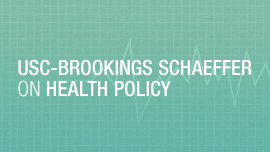This analysis is part of the USC-Brookings Schaeffer Initiative for Health Policy, which is a partnership between Economic Studies at Brookings and the University of Southern California Schaeffer Center for Health Policy & Economics. The Initiative aims to inform the national health care debate with rigorous, evidence-based analysis leading to practical recommendations using the collaborative strengths of USC and Brookings.
On Thursday, the Trump administration finalized a rule that will let employers pay for their workers’ health insurance by subsidizing premiums in Obamacare’s individual market. The rule does this by expanding the use of Health Reimbursement Arrangements, or HRAs, and is generally similar to the October proposed rule. We published a detailed assessment of the proposed rule last fall and much of that analysis remain relevant, but there are some interesting and even surprising features in this final rule.
In particular, the rule adopts a new limitation on age variation in the amounts made available through an HRA, which, in most instances, will result in older workers paying more than younger workers to obtain the same coverage. It also makes some changes to the way employers are permitted to determine which employees will be offered an HRA. It sticks with a January 1, 2020 effective date, which will likely cause confusion for workers and add to the rule’s fiscal cost. Finally, the rule makes clear that employers will have to do very little to verify whether their workers are buying the comprehensive coverage required by the rule – rather than more limited coverage types that are increasingly being marketed to consumers – which could significantly worsen the rule’s impact on the individual market.
Overview of the Rule
First, it is useful to briefly summarize what the rule does. Under the rule, employers will now be allowed to provide their employees with a fixed amount of money each year in a tax-preferred “individual coverage HRA” that the employee can use to buy coverage in the individual market. Importantly, employers will generally have to make decisions about what to offer with respect to entire classes of workers (not individual workers) and will not be permitted to offer the same class of workers both an individual coverage HRA and a traditional group health plan. Nevertheless, because individual market coverage is community rated, large employers with sicker workforces will be disproportionately likely to take up these HRAs. As a result, the final rule will likely increase premiums in the individual market.
The final rule also creates an “excepted benefit” HRA that can be used for purposes like paying directly for health care services, paying for cost-sharing, or buying short-term limited-duration insurance. Whether the employer offers an individual coverage HRA, excepted benefit HRA, or some other type of account-based benefit will have important tax consequences for the employee, changing their eligibility for the ACA’s premium tax credit and affecting whether they should buy coverage through a Health Insurance Marketplace or if they must buy coverage directly from an insurance company.
Notable Features of the Final Rule
In general, the final rule would have similar effects—and raise similar concerns—as the proposed rule. However, there are a pair of notable policy changes in the final rule:
- Limitations on age variation in HRA contributions: The final rule newly limits the extent to which employers are permitted to vary individual coverage HRA contributions by age. Under the rule, HRA contributions can vary by no more than 3:1 for older as compared to younger workers. While this is the ratio by which individual market premiums vary, it means that older employees will always pay more than younger employees for the same coverage unless the HRA contributions are large enough to cover the full premium. This change may have a variety of consequences, but one important consequence is that it will likely make transitioning from a traditional group health plan to an individual coverage HRA less attractive to employers by making it harder for employers to avoid leaving some workers worse off.
- Changes to guardrails against worker-level shifting: Observers – ourselves included – had been worried that a final rule would weaken or eliminate the guardrails that prevent the individual coverage HRA from causing employers’ sicker workers, and only their sicker workers, to shift into the individual market. While not perfectly effective, these guardrails were and are important. Without them, the administration’s proposal could have caused individual market premiums to almost double. Fortunately, they are largely preserved in the final rule.
However, the administration did make some changes. Two of the changes will make it harder for employers to shift sicker workers into the individual market. Particularly important, the final rule includes a new standard that limits employers’ ability to offer individual coverage HRAs to very small segments of their workforce, a change we had suggested could limit the risks posed by the proposed rule. Specifically, HRA offers based on full- or part-time status, geography, or salaried or hourly status are only permissible in cases where the resulting employer group is of sufficient size, generally the smaller of 20 employees or 10 percent of the workforce. The administration also prevents employers from treating employees under age 26 differently from older employees under individual coverage HRAs.But the administration also made countervailing changes that might make it easier for employers to shift sicker workers to the individual market: newly allowing employers to offer individual coverage HRAs only to salaried or hourly workers, only to workers employed or not employed through temporary staffing companies, or only to new hires. The overall effect of these various changes is uncertain, although our suspicion is that they will slightly reduce the risks the rule poses to the individual market on net.
There are also two aspects of the rule that did not change from the proposed, but for various reasons, look more problematic than they did when the proposed rule was published in October:
- Effective date: Perhaps surprisingly in light of how much time has passed since publication of the proposal, the final rule retains a January 1, 2020 effective date and thus will be relevant for consumers making decisions at the beginning of open enrollment on November 1, 2019. That gives Marketplaces less than five months to make necessary changes to enrollment systems and materials. A range of stakeholders expressed concern about that effective date in responding to the proposed rule, and State-Based Marketplaces recently made clear that they cannot be ready to make accurate eligibility determinations if the rule takes effect for 2020. The discussion in the preamble of the final rule suggests that the federal Marketplace will also not be ready, and instead will encourage individuals to perform their own eligibility determinations using a separate tool. The administration also released a long and detailed model notice employers may provide to employee offered HRAs, but it is unclear how helpful that will be.Therefore, some consumers are likely to be confused or receive financial assistance that they are not eligible for. In such instances, consumers would generally be required to later repay at least part of that assistance. It is possible that the administration would consider taking future steps to relieve individuals of these statutory repayment obligations, but the preamble to the final rule indicates that Treasury and IRS have concluded they lack legal authority to do so, and any such steps would come with an additional fiscal cost.[1] The disruption caused by this early effective date is difficult to justify given that the benefits associated with providing earlier access to these new types of HRAs are limited at best, and likely non-existent.
- Substantiation procedures for individual coverage HRAs: Individuals are only allowed to claim reimbursement from an individual coverage HRA when they are actually enrolled in individual market coverage. This requirement is important to ensure that people enrolled in individual coverage HRAs are not, in effect, given the option to use the HRA funds to purchase coverage other than individual market coverage, like short-term limited-duration insurance. As we noted in earlier analyses, allowing such a choice could greatly magnify the adverse effects individual coverage HRAs might have on the individual market risk pool.The final rule reiterates that employers may enforce this requirement through an attestation from the covered individual that they have suitable coverage. But it also makes clear in its response to stakeholder comments that the administration will not expect employers to “look behind” employees’ attestations in any meaningful way. In addition, a new model attestation form makes no mention of the fact that certain coverage does not qualify. This absence of compliance measures is concerning in light of mounting evidence that non-traditional forms of coverage like short-term limited-duration insurance and health care sharing ministries – which should not qualify under these rules – use marketing techniques that make it difficult for individuals to distinguish between them and individual market coverage. In this environment, the attestation process may be quite a bit more porous than other situations that rely on attestation. If so, individual coverage HRAs may in fact frequently subsidize non-individual-market coverage in practice, significantly increasing the risk to the individual market.
Overall Assessment of the Final Rule
More generally, our analysis of the proposed rule largely holds. In particular:
- The negative effects of allowing firms to subsidize the purchase of individual market coverage, particularly the increase in individual market premiums and the attendant federal fiscal costs, are likely to outweigh the benefits to employers and their workers. (The administration estimates the fiscal cost at $51 billion over ten years, although there are some shortcomings in its methodology that mean the true figure could be higher or lower.)
- These negative effects will be felt most acutely in states that today have individual markets with a relatively low-cost mix of enrollees. The healthier a state’s individual market is today, the more incentive employers with sicker workforces will have to shift their employees into the individual market – thus weakening the state’s individual market risk pool.
- Changes in employer coverage arrangements under the rule will create winners and losers within firms to the extent that firms do not make offsetting changes to their compensation structures, with younger and higher-income workers generally benefiting at the expense of older and lower-income workers. The final rule’s limitation on how much contributions to individual coverage HRAs can vary by age makes such effects more likely.
- The excepted benefit HRA also remains unattractive on policy grounds. At best, it represents a poorly targeted use of federal funds. At worst, it may induce some employers to make changes that shift costs from their healthier workers onto their sicker workers.
- The proliferation of HRA varieties and the complex rules attendant to each one could leave employees confused, potentially resulting in unexpected tax liability or additional fiscal cost. As noted above, these concerns are especially acute for 2020, when the Marketplaces will not be ready to make accurate eligibility determinations for individuals offered HRAs.
- The final rule suffers from the same legal vulnerabilities as the proposed. HRAs do not comply with ACA consumer protections, including the prohibition on annual and lifetime limits and the requirement to cover preventive services. Neither approach taken in the final rule – of “integrating” the employer’s HRA with an unrelated individual market plan or of classifying the HRA as an excepted benefit – appears consistent with the administration’s statutory authority.
In sum, the final rule largely refrains from making changes that would have dramatically worsened its impact on individual market premiums, and makes a few minor changes, some of which are improvements. But it remains, in our view, a step in the wrong direction on net.
[1] This sentence has been updated to reflect preamble language regarding legal authority to temporarily waive the repayment requirement.”
The Brookings Institution is committed to quality, independence, and impact.
We are supported by a diverse array of funders. In line with our values and policies, each Brookings publication represents the sole views of its author(s).









Commentary
The Trump administration’s final HRA rule: Similar to the proposed but some notable choices
June 14, 2019